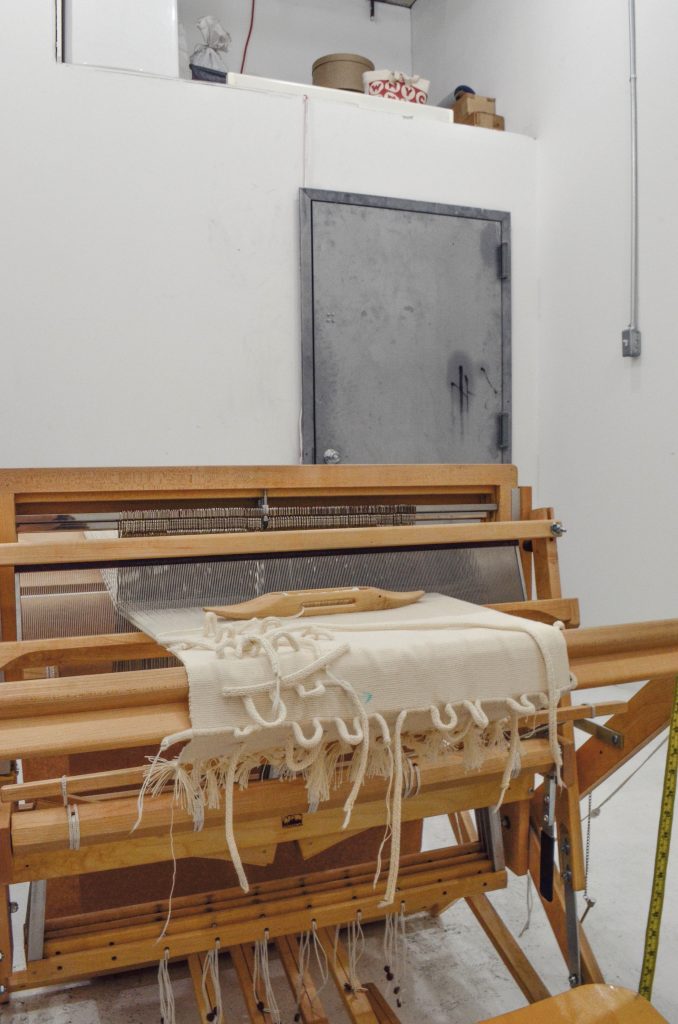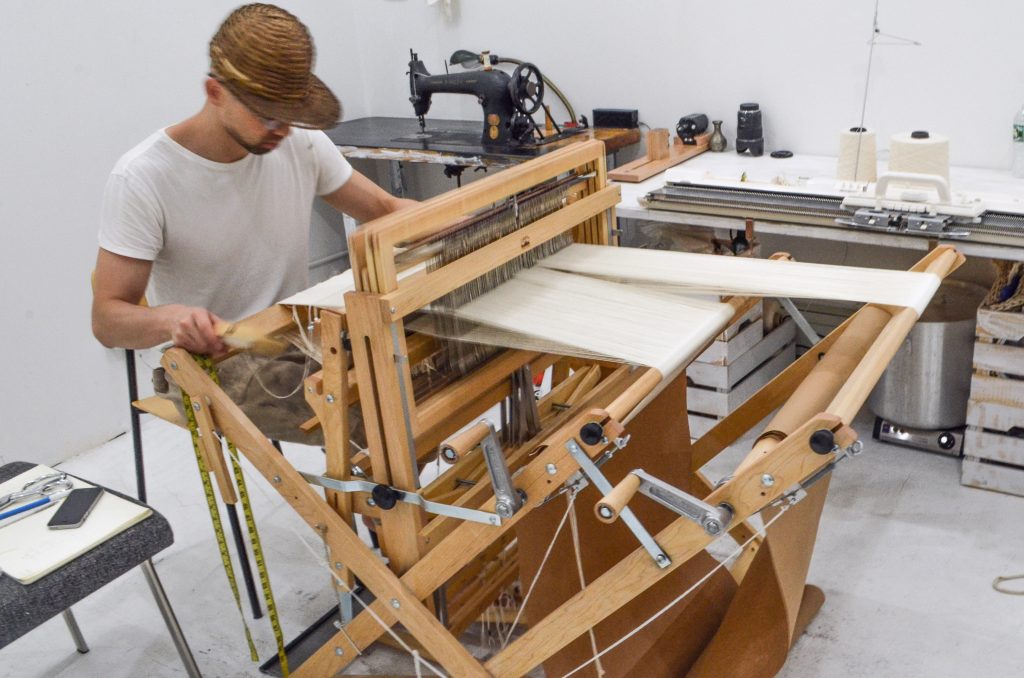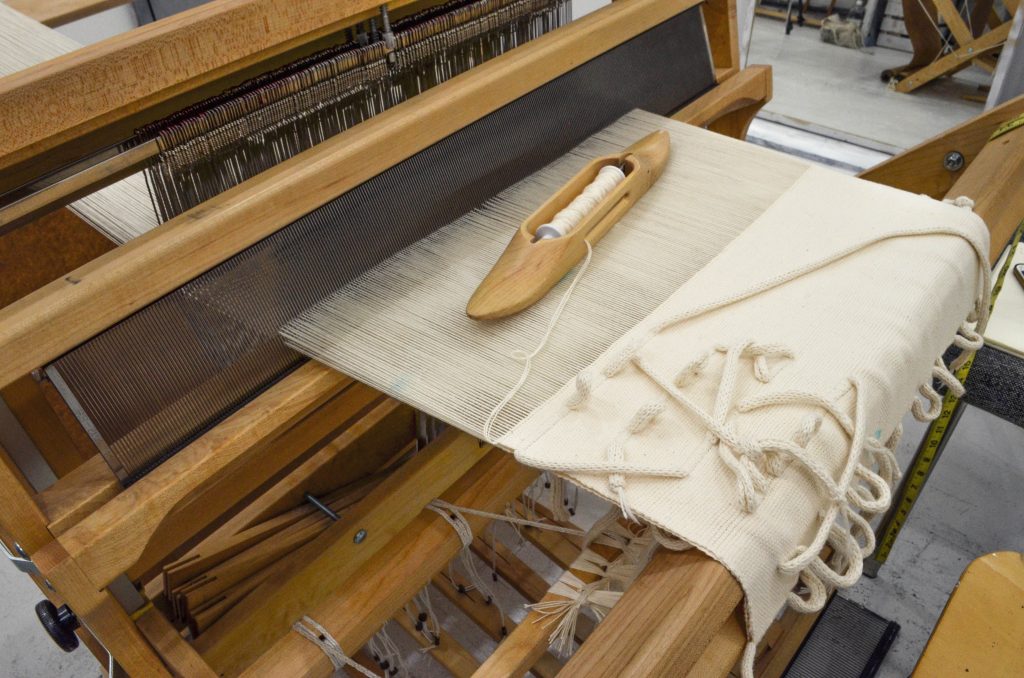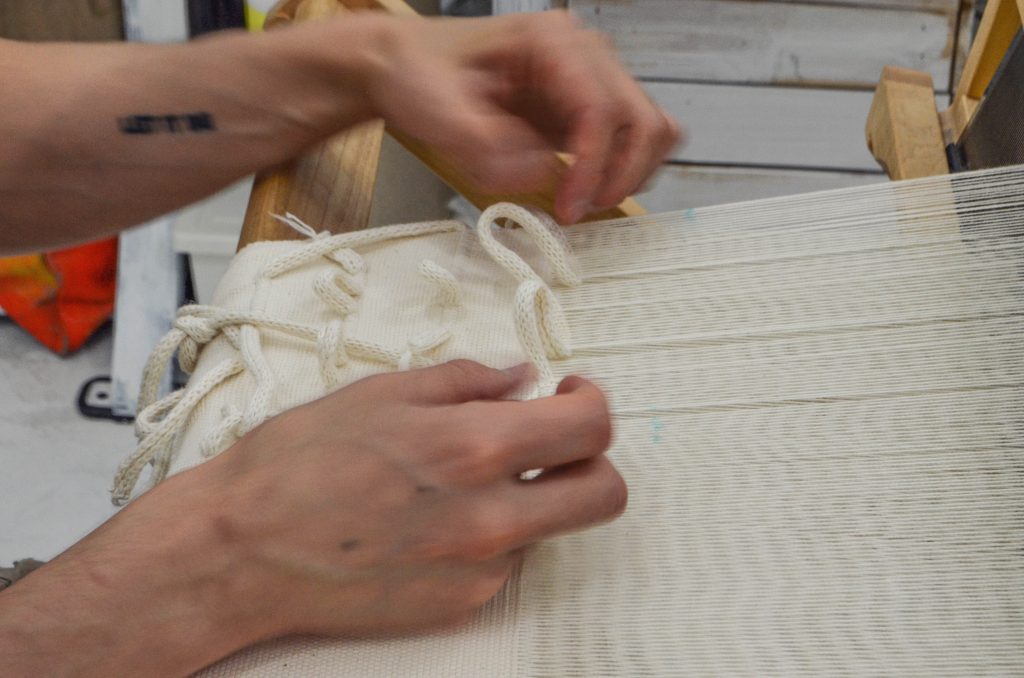Manonik
Going local in the fashion industry has been a slow and arduous journey. The food industry has managed to shift consumer attitudes toward eating locally and in season, however with fashion this shift hasn’t been quite so effortless. Fabric mills, factories and farmers are not as readily available everywhere as they used to be, and designers buy fabrics that they might not even now the origin of. That’s why a designer such as Yoshi of Manonik is a rarity, and is certainly swimming against the current. Manonik’s garments are local from seed to garment; no part of the process has been imported. The brand is embracing the best of what the US has to offer in terms of the organic cotton industry, local skilled artisans and natural dyes. We talked to Yoshi about what is it about locality that he finds fascinating, the state of fashion education and experimentation.
How did you get started with the shirts you make?
When I started weaving, I was just weaving rectangular cloths just like everyone else. Trying to experiment with the textures, not so much structures or colors. I learned that people used to weave simple shapes and I thought maybe I could push that further to make more contemporary clothes. I started with shaping the neck, expanded to arm holes, curving the waist line, sleeves with the shoulder cap. It took at least two years to get to where I am now and now I’m developing the idea of weaving three dimensional parts to create clothes sculpturally.
Why do you take process videos of your work?
What I learned over the years is that it’s easier to show than to explain my processes. For example, when I say I weave cloths, most people don’t quite know what that entails exactly. I need to count warp threads, take each thread through the reed, heddles, wind them to the back beam, and check the tension before the actual weaving can start. I think as a brand, it’s important to educate the audience about how I make garments.
Did you do a fashion design degree here?
No. I studied economic sociology, and I was doing graphic design and art direction in advertising until 2014. I don’t have a graphic design degree, either, but I always liked making stuff since I was a kid. My mom used to make a lot of textile stuff – and she still does – so I felt very familiar to the craft. When I started taking classes in tailoring, sewing, knitting and especially after I got on the loom, I knew I was meant to make clothes. The concept of what I do now is based on what I studied in college and partly the culture I grew up in.
Did it take long for you to learn the craft?
I became serious about the craft around 2012. It’s been six years of finessing the craft every day, experimenting and failing, analyzing the failure and improving it. What I do isn’t something that you can learn from the internet, books, or other teachers. I do a lot of hand manipulations and I’ve also developed and still developing the processes and techniques that no one else or only a few is using. So, in that sense. I’m still learning and probably always will.
how can you try to change the system if you don’t study it
I was looking at your website and it’s really interesting how you describe each individual material and where everything comes from. What made you so interested in locality and sourcing locally?
Initially I was just interested in transparency, because we, as consumers, don’t really know where things come from. Even if it says on the label, something is made in New York, it doesn’t necessarily mean that every component was made in New York. When I started, I was using different kinds of materials from different countries like hemp, banana silk. I guess I specifically became interested in locality, because I felt like there was a void in that area, especially in the luxury market. The idea of sustainability has become ubiquitous, but there isn’t really a movement in terms of locality. Also, I’ve had this inclination to make things with the things that was around since I was a kid, like milk containers and cardboard boxes, stuff like that. So I’m pretty sure that facilitated my move toward locality.
You say you pick things up in your local area?
Yes. I like having personal relationships with the farms and their materials. I think they make my work more grounded. Materials don’t magically appear, you know? They were made by someone somewhere and, often times, with an incredible amount of labor and care that we somehow decided not to acknowledge over the years. Their stories also need to be told as part of my process.
You also handspin some of the yarns from wool?
Yes, I handspin the weft yarn with a drop spindle for my winter pieces.
You also work with ethical and sustainable farms. It’s definitely rare to find designers like that.
I think quality is very important, but I also think how the farms craft their materials is also important. I visit the people I work with so that I can see their farms first hand. In my opinion. local farms are usually ethical and sustainable because of their scale and the reasons why they decided to remain small.
I think the reason why there aren’t many designers who work with ethical and sustainable farms is because fashion students are mostly taught to be successful within the existing Fashion system.
And not changing the system.
Yes. I’ve also noticed that fashion schools have been trying to dismantle Fashion as the system, but, at the same time, I also feel like they’re still working within the existing culture or the mindset of Fashion. We can’t change Fashion as the system without fully understanding the historicity which gave birth to it, and that includes economics, politics, sociology, histories and so on, which often get neglected when the focus is making fashionable clothes.
You categorise yourself within sustainable fashion?
I don’t categorise myself as a “sustainable” designer. I’m interested in using things that are around, I’m interested in having personal relationships with the people that make the materials. I just enjoy having those relationships and knowing where things come from. I mainly use natural materials that will decompose on their own. I only make a very small number of pieces each month. If my practice is considered to be sustainable fashion, then it may be, but that is my intention. I think that categorizing myself or brand as one thing will limit the creativity and the possible outcomes.
What’s the importance of craftsmanship to you?
I consider what I do as the hybrid between art and craft, and design to a certain extent, and either of these cannot stand alone. Craftsmanship, to me, is the means to create functional objects and the basis of whatever I’m trying to express.
Are natural fibres important to you or do you just gravitate towards that?
I think that biodegradable is important and how the fibre is made is also important to me. I don’t really make a distinction between synthetic versus natural. It’s just that I haven’t found a fibre that is synthetic that meets all my criteria at the moment. The materials I can find in the US are just different kinds of wool and cotton.
You also offer repairs, do you find that longevity is a cornerstone of what you do?
Yes, and I think we have to change our mentality about consumption if we really wanna talk about sustainability. If we consume less or buy less, we’ll ultimately drive ourselves toward sustainability. I like to think that garments have their own lives. Each person wears a garment differently even if I make two of the same pieces, they’ll live different lives and they’ll inevitably become different pieces. I pour all of myself into each piece I make. So I want to make sure I’ll be there to mend them if they start to degrade, so that they can live along as they can. This kind of thinking might come from my Japanese background.
I think that’s an interesting aspect of Japanese culture.
It is. Mending, still to a certain extent, is considered low class as it was a craft of those who couldn’t afford to buy new things. I think that stigma is slowly going away though.
So transparency is also a really big part of your brand, we already talked about how it’s missing in fashion.
It’s not missing just in fashion, transparency is missing everywhere. That’s actually one of the things I learned in college. Like I said earlier, I studied economic sociology, and it’s basically looking into how our economy works from the sociological perspective. For the capitalists and those in control, the less knowledge we have, the better it is for them because they can manipulate us easily to attain their goals. If we, the common people, have more knowledge, we can make better decisions and build a better future. In terms of Manonik, I want to make sure to communicate everything about the pieces to the wearer because the story is what makes the piece different from the rest of the clothes that exist in the world.
How did you end up doing this from what you studied?
I knew I wanted to do something creative, so toward the end of college, I started taking graphic design classes. I loved it and my professors thought I had talent, so they hooked me up with an internship at a local design studio. After graduation, I started working as a graphic designer and art director at ad agencies, which I did for about ten years. I got burnt out to be honest. I was just being a cog within a system I was critical of, and I just couldn’t figure out how to keep going. Stress started manifesting physically, and I thought to myself maybe this isn’t something that I should be doing. I was also in the process of getting a green card and I couldn’t really just quit the job. So, in the meantime, I started taking classes outside of work, then I applied for the residency at the Textile Arts Center in Brooklyn and I was accepted. By then, I had my permanent residency, so I quit my job and moved to New York. And the rest was history.
You have a more experimental perspective, that maybe other sustainable designers don’t have. Where do you think it comes from?
You bring up a good point. I don’t think that I approach the production or the making of clothes in the same way as other fashion designers. They design, I make clothes as art pieces. I’m not really concerned about seasons, trends, etc. I’m just making sure that what I’m making is irreplaceable. I experiment a lot because I’m really not all that interested in replicating the same things twice, even if I’m reproducing the same piece. But I think it comes from my personality type. By nature, I’m not the type of person who can make pieces that look perfectly alike. I’m not good at that. So, I’ve developed this sensibility or skill to make variations even if it’s the same piece. Just like each one of us is different, I want each one of my objects to be different. I also think new things come out only from experiments and glitches in the system, not through the rigid systematic process.
I spoke to another weaver who loves the systematic process, so I feel like there are two types of weavers.
That maybe be true. I do enjoy the systematic process to a certain extent, but I use the systematic process to express whatever it is I’m trying to express, sometimes just how I feel that particular day. Repeating the same motion ten thousand times to weave a perfectly even cloth isn’t much of an interest to me. I’d rather let the machines do what they’re good at. We make mistakes, we make the unexpected, and I feel like that’s what’s unique about us as humans.








